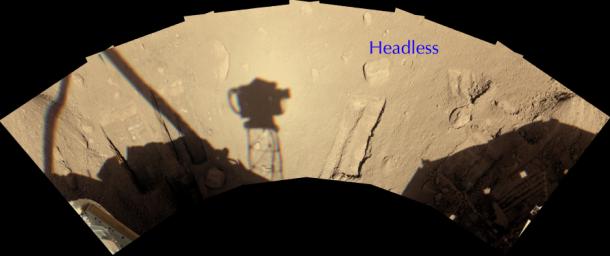
|
‘Headless’ Chosen for Attempt to Move a Martian Rock
- Click the image above for a larger view
- Full-Res JPEG (4067 x 1705) (582.6 kB)
- Full-Res TIFF (4067 x 1705) (20.8 MB)
Caption:
A rock informally named "Headless," on the north side of NASA's Phoenix Mars Lander, has been selected for an attempt to slide the rock aside with the lander's robotic arm.
Moving rocks is not among the many tasks the arm was designed to do, but if the maneuver can be accomplished, scientists on the Phoenix team hope to check whether the depth to a subsurface ice layer is any different underneath the area where the rock now sits.
Headless is about 19 centimeters (7 inches) long, 10 centimeters (4 inches) wide, extends 2 to 3 centimetes (about 1 inch) above the surface.
This image, originally posted on Aug. 27, 2008 without the label on Headless, is a mosaic of images taken by the Surface Stereo Imager on Phoenix, showing the workspace reachable with the robotic arm. The camera took the images during the early afternoon of the mission's 90th Martian day, corresponding to overnight Aug. 25 to Aug. 26.
The shadow of the the camera itself, atop its mast, is just left of the center of the image and roughly a third of a meter (one foot) wide.
Background Info:
The Phoenix Mission is led by the University of Arizona, Tucson, on behalf of NASA. Project management of the mission is by NASA's Jet Propulsion Laboratory, Pasadena, Calif. Spacecraft development is by Lockheed Martin Space Systems, Denver.
Photojournal Note: As planned, the Phoenix lander, which landed May 25, 2008 23:53 UTC, ended communications in November 2008, about six months after landing, when its solar panels ceased operating in the dark Martian winter.
Cataloging Keywords:
| Name | Value | Additional Values |
|---|---|---|
| Target | Mars | |
| System | ||
| Target Type | Planet | |
| Mission | Phoenix | |
| Instrument Host | Phoenix Lander | |
| Host Type | Lander | |
| Instrument | Solid-State Imaging (SSI) | |
| Detector | ||
| Extra Keywords | Color, Shadow | |
| Acquisition Date | ||
| Release Date | 2008-09-22 | |
| Date in Caption | 2008-08-27 | |
| Image Credit | NASA/JPL-Caltech/University of Arizona/ Texas A&M University | |
| Source | photojournal.jpl.nasa.gov/catalog/PIA11187 | |
| Identifier | PIA11187 | |
